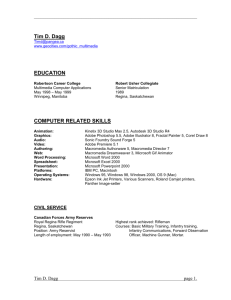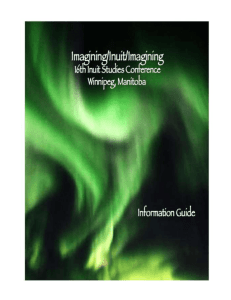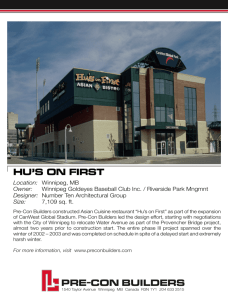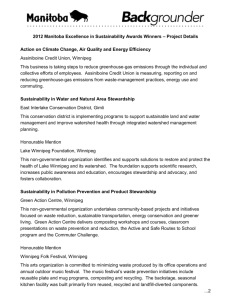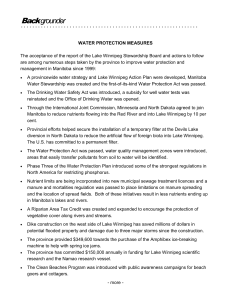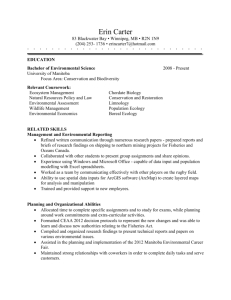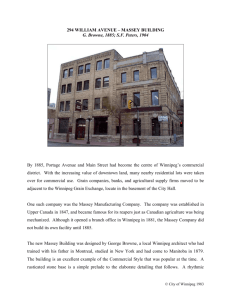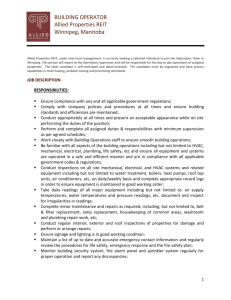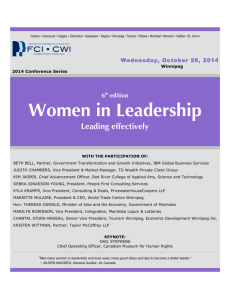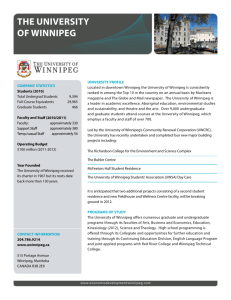Canada - Spanker
advertisement
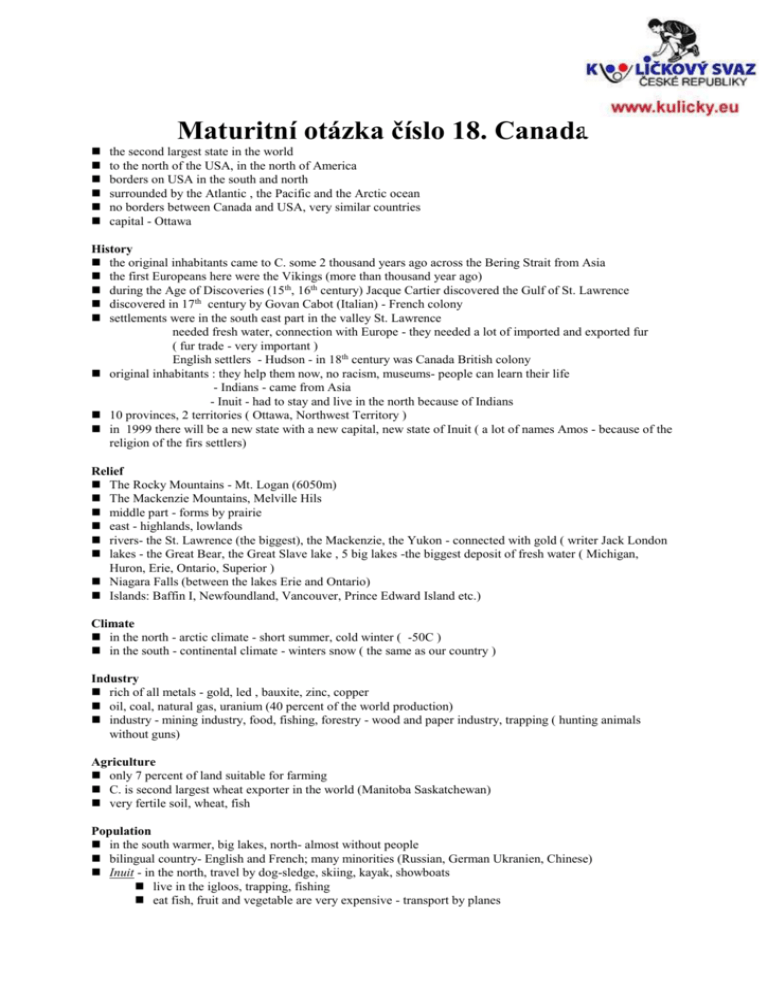
Maturitní otázka číslo 18. Canada the second largest state in the world to the north of the USA, in the north of America borders on USA in the south and north surrounded by the Atlantic , the Pacific and the Arctic ocean no borders between Canada and USA, very similar countries capital - Ottawa History the original inhabitants came to C. some 2 thousand years ago across the Bering Strait from Asia the first Europeans here were the Vikings (more than thousand year ago) during the Age of Discoveries (15th, 16th century) Jacque Cartier discovered the Gulf of St. Lawrence discovered in 17th century by Govan Cabot (Italian) - French colony settlements were in the south east part in the valley St. Lawrence needed fresh water, connection with Europe - they needed a lot of imported and exported fur ( fur trade - very important ) English settlers - Hudson - in 18th century was Canada British colony original inhabitants : they help them now, no racism, museums- people can learn their life - Indians - came from Asia - Inuit - had to stay and live in the north because of Indians 10 provinces, 2 territories ( Ottawa, Northwest Territory ) in 1999 there will be a new state with a new capital, new state of Inuit ( a lot of names Amos - because of the religion of the firs settlers) Relief The Rocky Mountains - Mt. Logan (6050m) The Mackenzie Mountains, Melville Hils middle part - forms by prairie east - highlands, lowlands rivers- the St. Lawrence (the biggest), the Mackenzie, the Yukon - connected with gold ( writer Jack London lakes - the Great Bear, the Great Slave lake , 5 big lakes -the biggest deposit of fresh water ( Michigan, Huron, Erie, Ontario, Superior ) Niagara Falls (between the lakes Erie and Ontario) Islands: Baffin I, Newfoundland, Vancouver, Prince Edward Island etc.) Climate in the north - arctic climate - short summer, cold winter ( -50C ) in the south - continental climate - winters snow ( the same as our country ) Industry rich of all metals - gold, led , bauxite, zinc, copper oil, coal, natural gas, uranium (40 percent of the world production) industry - mining industry, food, fishing, forestry - wood and paper industry, trapping ( hunting animals without guns) Agriculture only 7 percent of land suitable for farming C. is second largest wheat exporter in the world (Manitoba Saskatchewan) very fertile soil, wheat, fish Population in the south warmer, big lakes, north- almost without people bilingual country- English and French; many minorities (Russian, German Ukranien, Chinese) Inuit - in the north, travel by dog-sledge, skiing, kayak, showboats live in the igloos, trapping, fishing eat fish, fruit and vegetable are very expensive - transport by planes parka - special warm cloth Indians – they call themselves first nation, they live in the reservations, in normal houses, they use cars … - in the middle still live their traditional life connected with hunting, not enough education - poor living conditions, taking drugs, drug addict, unemployment... they have a lot of advantages- free education, government gives then a lot of land they can hunt, live their traditional life but their children have to attend schools they are very proud of their history, many museums (Museum of clothes, Museum of First settlements) Flag red and white = blood and snow Symbol – maple leaf Animals: loon, polar bear, polar fox Political system: Canada has independent parliamentary system with Queen Elisabet II. As a head of the state. The federal parliament consist of the House of Commons and the Senate. The leading figure in political life is prime minister. C. is a member of the UN, UNESCO, NATO etc. Famous figures James Fenimoor Cooper – The last of the Mohicans- about Indians near lake Huron Ernest Thompson Seton – Two little Savages CANADIAN CITIES Montreal Montreal lies in Quebec and it is the second largest French speaking city. It is situated on an island n the middle of the St. Lawrence River. Montreal was chosen as the site of the Universal Exhibition (Expo 67) and the (21st) Summer Olympic games took place there in 1976. It is a great industrial, commercial, and financial and tourist centre. Winnipeg Winnipeg is the capital of Manitoba. It is located in the prairie, at the junction of the Red and Assiniboine Rivers. It is a cultural, commercial and historical centre. People in Winnipeg are very proud of their culture and history. They built a lot of museums, galleries, churches, theatres and so on. Museums: Children’s museum, Living prairie Museum and Canada’s first costume museum Dugald costume museum. There are a lot of parks in W. as well. For example, Sargent Park or Assiniboine Park which is Winnipeg’s oldest and largest park. In this park there are the English Gardens, the zoo, picnic sites, a lot of special areas for different kinds of sports. A lot of festivals take place there e.g. Winnipeg Folk Festival, W. Fringe Festival… The world’s largest celebration takes place in Winnipeg. This celebration is called Folklorama and it lasts two weeks in August. Winnipeg’s “French Quarter” is a historical and cultural cornerstone of the city. It is the largest French–Canadian community in Canada, west of Quebec. In Manitoba there is the provincial park called Whiteshell. In this park there are the stones called Petroforms. They are arranged in the shapes of snakes, turtles, humans…It was made by Native people for religious purposes. Toronto Toronto is the biggest city in Canada. It is the capital of the province of Ontario. It is situated on the bank of Lake Ontario. There is a very famous the City Hall in T. Vancouver Vancouver is situated in British Columbia it is one of the important ports in Canada. The Universal Exhibition (Expo 86) took place there. Canada has its own national flag since 1964. It is red and in the centre there is a white square with a simple red maple leaf.
